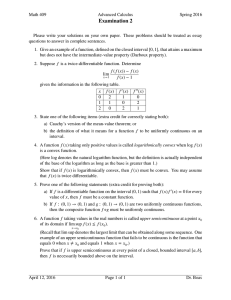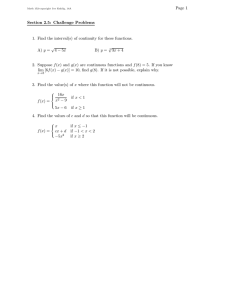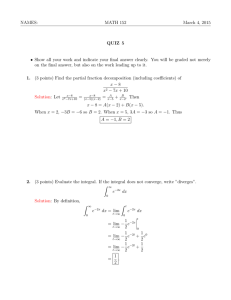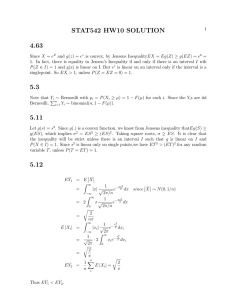Hindawi Publishing Corporation Journal of Inequalities and Applications
advertisement
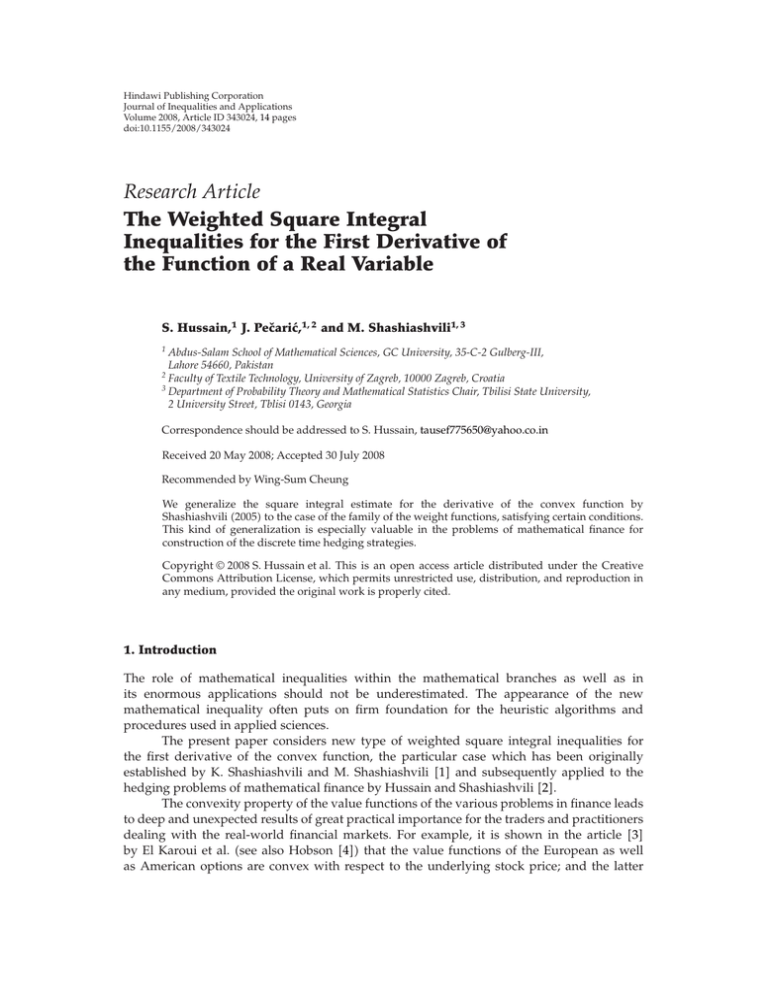
Hindawi Publishing Corporation
Journal of Inequalities and Applications
Volume 2008, Article ID 343024, 14 pages
doi:10.1155/2008/343024
Research Article
The Weighted Square Integral
Inequalities for the First Derivative of
the Function of a Real Variable
S. Hussain,1 J. Pečarić,1, 2 and M. Shashiashvili1, 3
1
Abdus-Salam School of Mathematical Sciences, GC University, 35-C-2 Gulberg-III,
Lahore 54660, Pakistan
2
Faculty of Textile Technology, University of Zagreb, 10000 Zagreb, Croatia
3
Department of Probability Theory and Mathematical Statistics Chair, Tbilisi State University,
2 University Street, Tblisi 0143, Georgia
Correspondence should be addressed to S. Hussain, tausef775650@yahoo.co.in
Received 20 May 2008; Accepted 30 July 2008
Recommended by Wing-Sum Cheung
We generalize the square integral estimate for the derivative of the convex function by
Shashiashvili 2005 to the case of the family of the weight functions, satisfying certain conditions.
This kind of generalization is especially valuable in the problems of mathematical finance for
construction of the discrete time hedging strategies.
Copyright q 2008 S. Hussain et al. This is an open access article distributed under the Creative
Commons Attribution License, which permits unrestricted use, distribution, and reproduction in
any medium, provided the original work is properly cited.
1. Introduction
The role of mathematical inequalities within the mathematical branches as well as in
its enormous applications should not be underestimated. The appearance of the new
mathematical inequality often puts on firm foundation for the heuristic algorithms and
procedures used in applied sciences.
The present paper considers new type of weighted square integral inequalities for
the first derivative of the convex function, the particular case which has been originally
established by K. Shashiashvili and M. Shashiashvili 1 and subsequently applied to the
hedging problems of mathematical finance by Hussain and Shashiashvili 2.
The convexity property of the value functions of the various problems in finance leads
to deep and unexpected results of great practical importance for the traders and practitioners
dealing with the real-world financial markets. For example, it is shown in the article 3
by El Karoui et al. see also Hobson 4 that the value functions of the European as well
as American options are convex with respect to the underlying stock price; and the latter
2
Journal of Inequalities and Applications
property gives us the following remarkable robustness result. Even if the writer of the option
uses incorrect mathematical model to describe the dynamics of stock prices, he is able to
carry out his liabilities if only the incorrectly chosen volatility dominates the true volatility
function.
The present paper is organized as follows. In Section 2 we prove the weighted
square integral estimates for the first derivative of a function that is assumed to be twice
continuously differentiable. Afterwards in Section 3 we consider more general case of the
arbitrary convex functions which are not supposed even one time continuously differentiable.
We emphasize the fact that the latter case can be directly applied to problems of mathematical
finance, especially to discrete time hedging of the European as well as American call options.
2. The weighted square integral estimates for the first derivative of
a twice continuously differentiable function
In this section, we consider the pair of twice continuously differential functions fx and gx
defined on the closed bounded interval a, b. We assume that the function gx is convex
that is g x ≥ 0 and the following requirement is satisfied:
|f x| ≤ g x,
a ≤ x ≤ b.
2.1
Introduce the family of nonnegative twice continuously differentiable weight functions
Hx, a ≤ x ≤ b, which satisfy the condition
Ha Hb 0,
H a H b 0.
2.2
Theorem 2.1. Let fx and gx be two twice continuously differentiable functions defined on the
bounded interval a, b, which satisfy the requirement 2.1 and letHx, a ≤ x ≤ b be arbitrary
nonnegative weight function such that condition 2.2 is fulfilled. Then the following inequality is
valid:
b 2
b
f x
2
sup |fx| gx H xdx.
f x Hxdx ≤
2.3
2
a
a
a≤x≤b
Proof. Using the integration-by-parts formula in the integral below, we have
b
b b
2
f x Hxdx fx f x Hx − f H x fxdx
a
−
b
a
a
fx f x H xdx −
a
1
−
2
b
a
b
fx f x Hxdx
2 f x H xdx −
b
fx f x Hxdx
a
as Ha Hb 0.
Let us transform the integral
b
1 b 2 1 2
1 b 2
f x H xdx f xH x −
f xH xdx
2 a
2
2 a
a
1 b 2
−
f xH xdx
2 a
using the condition H a H b 0.
2.4
a
2.5
S. Hussain et al.
3
Inserting the latter expression in equality 2.4, we obtain the estimate
b
1
f x Hxdx 2
a
2
≤
≤
1
2
1
2
b
f xH xdx −
2
a
b
b
f 2 xH xdx b
a
b
fx f x Hxdx
a
|fx| |f x|Hxdx
a
f 2 xH xdx sup |fx|
a
b
2.6
|f x|Hxdx.
a
a≤x≤b
Taking into account requirement 2.1, we get from the latter inequality 2.6
b
1
f x Hxdx ≤
2
a
2
b
f xH xdx sup |fx|
2
a
b
g xHxdx.
2.7
a
a≤x≤b
Now we use twice the integration-by-parts formula and obtain
b
a
b b
g xHxdx g x Hx − g x H xdx
a
a
b b
−gx H x gxH xdx
b
a
2.8
a
gxH xdx.
a
The latter equality together with the previous estimate 2.7 give us the required inequality
2.3.
Applying Hölder inequality to the right-hand side of estimate 2.3, we get the
following.
Corollary 2.2. For the functions fx, gx, and the weight function Hx, satisfying the same
conditions as in Theorem 2.1, the following bound is valid
b
f x Hxdx ≤ f∞
2
a
1
fp gp H q ,
2
2.9
where 1 ≤ p ≤ ∞, and p and q are conjugate exponents, and
fp b
1/p
p
|fx| dx
,
1 ≤ p < ∞,
f∞ sup |fx|.
a
2.10
a≤x≤b
Remark 2.3. Let us notice that assumption 2.1, |f x| ≤ g x, is equivalent to the existence
of the decomposition of the function fx as the difference of two twice continuously
differentiable convex functions fx f1 x − f2 x, a ≤ x ≤ b such that f1 x f2 x gx.
Indeed the inequality |f x| ≤ g x is the same as −g x ≤ f x ≤ g x, that is,
f x g x ≥ 0,
g x − f x ≥ 0.
2.11
4
Journal of Inequalities and Applications
The latter means that the functions
f1 x 1
fx gx,
2
f2 x 1
gx − fx
2
2.12
are two convex functions such that
fx f1 x − f2 x,
gx f1 x f2 x.
2.13
This remark suggests to write inequality 2.9 in a different form. Take two arbitrary
twice continuously differentiable convex functions f1 x and f2 x and define
fx f1 x − f2 x,
gx f1 x f2 x,
2.14
f x f1 x − f2 x, and g x f1 x f2 x, it is obvious that |f x| ≤ g x, then the
inequality in Corollary 2.2 will take the following form:
b
1
2
f1 − f2 p f1 f2 p H q ,
f1 x − f2 x Hxdx ≤ f1 − f2 ∞
2.15
2
a
where 1 ≤ p ≤ ∞.
Consider the special case of the latter inequality when p ∞ and Hx is of the
particular form
Hx x − a2 b − x2 ,
a ≤ x ≤ b.
2.16
Corollary 2.4. Let f1 x and f2 x be two twice continuously differentiable convex functions defined
on a closed bounded interval a, b and let the weight function Hx be equal to
Hx x − a2 b − x2 ,
a ≤ x ≤ b.
Then the following estimate holds
√
b
√
2 3
4 3
2
f1 f2 ∞ f1 − f2 ∞ b − a3 .
f1 x − f2 x Hxdx ≤ f1 − f2 ∞
9
9
a
2.17
2.18
Proof. We have
H x 12x2 − 12a bx 2 a2 4ab b2 .
Calculate the integral
b
a
b
|H x|dx 2 |6x2 − 6a bx a2 4ab b2 |dx.
2.19
2.20
a
Let us introduce the change of variable x a ub − a, 0 ≤ u ≤ 1; from the above expression,
we obtain
√
1
b
4 3
3
2
b − a3 .
|H x|dx 2 b − a |6u − 6u 1|du 2.21
9
a
0
Taking into account the latter expression in estimate 2.9, we come to the desired inequality
2.18.
Remark 2.5. Comparing the result stated in Corollary 2.4 with Theorem 2.1 from
√ K.
Shashiashvili and M. Shashiashvili 1, we come to the conclusion that the multiplier 4 3/9
is twice less than obtained in the latter paper.
S. Hussain et al.
5
3. The weighted square integral estimates for the difference of
derivatives of two convex functions
In this section, we consider two arbitrary finite convex functions fx and gx on an infinite
interval 0, ∞. It is well known that they are continuous and have finite left- and right-hand
derivatives f x−, f x and g x−, g x inside the open interval 0, ∞.
We will assume that there exists a positive number A such that if x ≥ A, we have
|f x−| ≤ C,
|g x−| ≤ C,
3.1
where C is certain positive constant.
Let us assume also that the difference of the functions fx and gx is bounded on
the infinite interval 0, ∞:
sup|fx − gx| < ∞.
3.2
x≥0
Introduce now the family of nonnegative twice continuously differentiable weight functions
Hx defined on the open interval 0, ∞, which satisfy the following conditions:
lim Hx 0,
lim Hx 0,
x→ ∞
x→ 0
∞
lim H x 0,
x→ 0
lim x H x 0,
x→∞
|fx| |gx| |H x|dx < ∞
3.3
3.4
0
this integral is understood in the improper sense as the limit
b
lim
δ→0 δ
b→∞
|fx| |gx| |H x|dx.
3.5
Theorem 3.1. For arbitrary two finite convex functions fx and gx defined on 0, ∞ satisfying
conditions 3.1 and 3.2 and for any nonnegative twice continuously differentiable weight function
Hx, 0 < x < ∞, which satisfy conditions 3.3 and 3.4, the following energy estimate is valid:
∞
0
f x− − g x− Hxdx ≤
2
3
sup|fx − gx|
2 x≥0
∞
|fx| |gx| |H x|dx,
3.6
0
where f x− and g x− denote the left derivatives of the convex functions fx and gx,
respectively.
Proof. We will prove the theorem in two stages. On first stage, we verify the validity of the
statement for twice continuously differentiable convex functions satisfying conditions 3.1
and 3.2 and on second stage we approximate arbitrary convex functions satisfying the same
conditions by smooth ones inside the interval 0, ∞ in an appropriate manner and afterwards
we pass onto limit in the previously established estimate.
Thus let us assume at first that fx and gx are two convex functions defined on
the interval 0, ∞ which are twice continuously differentiable in the open interval 0, ∞ and
satisfy conditions 3.1 and 3.2.
6
Journal of Inequalities and Applications
Introduce new function Fx as follows:
Fx fx − gx,
0 ≤ x < ∞,
3.7
then Fx is twice continuously differentiable inside the infinite interval 0, ∞ and at point
zero, it has finite limit F0.
Consider the following integral on a finite interval δ, b and use in it the integration
by parts formula here δ and b are arbitrary strictly positive numbers,
b
δ
b b
F xFH xdx F xFxHx − F xFxHxdx
δ
δ
FbF bHb − FδF δHδ −
b
3.8
F xFxHxdx.
δ
Now bound the absolute value of the last integral in 3.8:
b
b
F xFxHxdx ≤ sup |Fx| |f x − g x|Hxdx
δ
δ≤x≤b
≤ sup |Fx|
δ
b
3.9
f x g xHxdx,
δ
δ≤x≤b
as f x ≥ 0, g x ≥ 0, 0 < x < ∞.
Let us transform the integral on the right-hand side of inequality 3.9:
b
δ
b b
f x g xHxdx f x g xHx − f x g xH xdx
δ
δ
f b g bHb − f δ g δHδ
3.10
b b
− fx gxH x − fx gxH xdx ,
δ
δ
which implies
b
f x g xHxdx f b g bHb − f δ g δHδ − fb gbH b
δ
fδ gδH δ b
fx gxH xdx.
δ
3.11
Using the above expression in inequality 3.9, we obtain the estimate
b
F xFxHxdx ≤ sup |Fx| |f b g b|Hb |f δ g δ|Hδ
δ
δ≤x≤b
|fb gb||H b| |fδ gδ||H δ|
b
|fx gx||H x|dx .
δ
3.12
S. Hussain et al.
7
Thus from equality 3.8, we come to the following bound:
b
F xFH xdx ≤ |FbF b|Hb |FδF δ|Hδ
δ
sup |Fx| |f b g b|Hb |f δ g δ|Hδ
δ≤x≤b
3.13
|fb gb||H b| |fδ gδ||H δ|
b
|fx gx||H x|dx .
δ
On the other hand,
b
F xFH xdx δ
b
F x Hxdx 2
δ
b
Fx F x H xdx.
3.14
δ
From here we have the chain of equalities
b
F x Hxdx 2
δ
b
F xFH xdx −
δ
b
1
2
b
F 2 xH xdx
δ
b b
1
F xFH xdx −
F 2 xH x − F 2 xH xdx
2
δ
δ
δ
b
1
1
F xFH xdx − F 2 bH b F 2 δH δ
2
2
δ
1 b 2
F xH xdx.
2 δ
3.15
Using bound 3.13 in expression 3.15, we arrive to the estimate
b
F x Hxdx
2
δ
≤
1
1 2
F b |H b| F 2 δ |H δ| |FbF b| Hb
2
2
|FδF δ| Hδ sup |Fx|
3.16
δ≤x≤b
×
b
3
|fx| |gx||H x|dx |f b g b|Hb |f δ g δ| Hδ
2 δ
|fb gb| |H b| |fδ gδ| |H δ| .
It is well known that any convex function is locally absolutely continuous see, e.g., 5,
Proposition 17 of Chapter 5, that is,
fx2 − fx1 x2
x1
f u−du,
0 < x1 ≤ x2 < ∞,
3.17
8
Journal of Inequalities and Applications
where f u− denotes the left-derivative of the convex function fx at point u. As the lefthand derivative f x− of the convex function fx is nondecreasing function, we have
f x1 − ≤ f u− ≤ f x2 −,
if 0 < x1 ≤ u ≤ x2 < ∞.
3.18
f x1 − x2 − x1 ≤ fx2 − fx1 ≤ f x2 −x2 − x1 ,
3.19
Therefore, from expression 3.17, we find
where 0 < x1 ≤ x2 < ∞.
Taking x2 2x1 , we get
f x1 − x1 ≤ f2x1 − fx1 .
3.20
As x1 is arbitrary positive number, we have
f x− x ≤ f2x − fx
for x > 0.
3.21
On the other hand, letting x1 to zero in inequality 3.19, we write
fx2 − f0 ≤ f x2 − x2 ,
3.22
that is,
fx − f0 ≤ f x− x,
x > 0.
3.23
Ultimately we obtain the two-sided inequality
fx − f0 ≤ f x− x ≤ f2x − fx
for x > 0,
3.24
which gives
lim xf x− 0
similarly lim xg x− 0 .
x→0
x→0
3.25
By equality 3.17 and using condition 3.1, we obtain the bound
|fb| ≤ |fA| Cb − A ≤ |fA| Cb
for A ≤ b.
3.26
But we have
|fA| |fA|
|fA|
A≤
b
A
A
if A ≤ b.
3.27
Therefore we can write
|fbH b| ≤ |fAH b| Cb|H b| ≤
|fA|
C b|H b| if A ≤ b
A
3.28
and similar bound is valid for |gbH b|
|gbH b| ≤
|gA|
C b|H b| for A ≤ b.
A
3.29
S. Hussain et al.
9
Using condition 3.3 and bounds 3.28 and 3.29, we get
lim F 2 b|H b| ≤ sup |Fx| lim |fb| |gb| |H b| 0,
b→∞
b→∞
0≤x<∞
lim |fb gb||H b| 0.
b→∞
3.30
3.31
Moreover, from conditions 3.1 and 3.3, we find
lim F 2 δ|H δ| f0 − g02 lim |H δ| 0,
δ→0
δ→0
lim |FbF b−|Hb ≤ sup |Fx| lim |f b−| |g b−| Hb
b→∞
0≤x<∞
b→∞
≤ 2 C sup |Fx| lim Hb 0,
0≤x<∞
b→∞
3.32
lim |f b− g b−| Hb ≤ 2 C lim Hb 0,
b→∞
b→∞
lim |fδ gδ| |H δ| |f0 g0| lim |H δ| 0.
δ→0
δ→0
By the mean value theorem, we have
Hδ Hδ − H0
H ϑδ ,
δ
δ
where 0 < ϑδ < δ,
3.33
therefore from condition 3.3, we get
lim
δ→0
Hδ
0,
δ
3.34
using the limit relations above and 3.25 we find
lim |FδF δ−|Hδ ≤ sup |Fx| lim |f δ− − g δ−|Hδ
δ→0
0≤x<∞
δ→0
Hδ
Hδ
|δg δ−|
≤ sup |Fx| lim |δf δ−|
0,
δ→0
δ
δ
0≤x<∞
3.35
and similarly
lim |f δ− g δ−|Hδ 0.
δ→0
3.36
Now we have to pass onto limit when b → ∞ and δ → 0 in inequality 3.16. Obviously,
the left-hand side of the inequality increases and the right-hand side is bounded, when b →
∞, δ → 0, therefore the left-hand side also converges to finite limit. Passing onto limit δ →
0, b → ∞ in inequality 3.16 using assumption 3.4 and the limit relations 3.30–3.36, we
come to the required estimate 3.6.
Next we move to the second stage of the proof. Consider two arbitrary convex
functions fx and gx defined on 0, ∞, satisfying conditions 3.1 and 3.2. We have
to construct the sequences of twice continuously differentiable in the open interval 0, ∞
10
Journal of Inequalities and Applications
convex functions fn x and gn x approximating, respectively, the functions fx and gx
inside the interval 0, ∞ in an appropriate manner.
To construct such sequences, we will use the following smoothing function:
ρx ⎧
⎨c · exp
⎩
1
;
xx − 2
0;
0 < x < 2,
3.37
otherwise,
where the factor c is chosen to satisfy the equality
2
ρxdx 1.
3.38
0
Define for x ∈ 0, ∞
fn x gn x ∞
0
∞
nρnx − yfydy,
3.39
nρnx − ygydy,
0
where n 1, 2, . . . .
For arbitrary fixed δ > 0 consider the restriction of functions fn x and gn x on the
interval δ, b and let n ≥ 4/δ. Then nx ≥ 4 for x ∈ δ, b.
Perform in 3.39 the change of variable z nx − y, then we find
nx
z
ρzf x −
dz,
n
−∞
nx
z
dz.
ρzg x −
gn x n
−∞
fn x 3.40
Since the function ρz is equal to zero outside the interval 0, 2, we can write
2
z
dz,
ρzf x −
n
0
2
z
gn x ρzg x −
dz,
n
0
fn x 3.41
if x ∈ δ, b, n ≥ 4/δ.
From definition 3.39, it is obvious that the functions fn x and gn x are infinitely
differentiable, while their convexity follows from the expressions 3.41.
Now we will show the uniform convergence of the sequence fn x to fx on the
interval δ, b similarly, the uniform convergence of gn x to gx. For this purpose, we use
the uniform continuity of the function fx on the interval δ/2, b. For fix ε > 0 there exists
δ > 0 such that we have
δ
,b .
3.42
|fx2 − fx1 | ≤ ε if |x2 − x1 | < δ, x1 , x2 ∈
2
S. Hussain et al.
11
Then for 0 ≤ z ≤ 2 and x ∈ δ, b, we get
Take n ≥ max{4/δ, 4/δ}.
z
δ δ
≤ min
,
,
n
2 2
x−
z δ
≥ .
n 2
3.43
Hence
f x − z − fx ≤ ε
n
for n ≥ max
4 4
,
δ δ
3.44
and consequently
2
z
− fx dz ≤ ε
|fn x − fx| ρz f x −
n
0
3.45
for x ∈ δ, b and n ≥ max{4/δ, 4/δ}.
This shows the uniform convergence of the sequence fn x to fx and gn x to gx
on the interval δ, b.
Next we need to differentiate 3.41. For this purpose, we will use the following
inequality 5, page 114 concerning convex function fx and its left-derivative f x−
f x1 − ≤
fx2 − fx1 ≤ f x2 −,
x2 − x1
if 0 < x1 < x2 < ∞.
3.46
Take therein
x1 z
x−
n
− h,
x2 x −
z
,
n
where 0 < h < δ/4.
We have
fx − z/n − fx − z/n − h
z
z
≤ f
f
x− −h − ≤
x−
−
n
h
n
3.47
3.48
for x ∈ δ, b, 0 ≤ z ≤ 2, 0 < h < δ/4, and n ≥ 4/δ.
It is well known that the left derivative of the convex function is nondecreasing and as
x−
δ
z
−h≥ ,
n
4
x−
z
≤ b,
n
3.49
we can write
f
δ
−
4
≤
fx − z/n − fx − z/n − h
≤ f b−,
h
3.50
which shows that the family of functions
z Φn,x
h
fx − z/n − fx − z/n − h
h
3.51
12
Journal of Inequalities and Applications
is uniformly bounded by the constant D |f b−| |f δ/4−| if only x ∈ δ, b, 0 ≤ z ≤
2, 0 < h < δ/4, and n ≥ 4/δ.
Using expression 3.41, we can write
2
fx − z/n − fx − z/n − h
fn x − fn x − h
ρz
dz.
3.52
h
h
0
Taking limit as h tends to zero and using bounded convergence theorem, we obtain the
formula
2
z
fn x ρzf
− dz
3.53
x−
n
0
for x ∈ δ, b and n ≥ 4/δ.
Using 3.53 let us show that for fixed x ∈ δ, b, the sequence fn x converges to the
left-derivative f x−.
We have
2
z
− − f x− dz,
fn x − f x− ρz f
3.54
x−
n
0
where n ≥ 4/δ. Choose arbitrary ε > 0. Since the left-derivative f x− is left continuous, we
can find Nε such that for 0 ≤ z ≤ 2:
z
≤ ε if only n ≥ Nε.
f
3.55
x−
x
−
−
−
f
n
Hence we get
|fn x − f x−| ≤
2
ρz ε dz ε
if x ∈ δ, b, n ≥ max
0
4
, Nε ,
δ
3.56
that is,
lim fn x f x−
n→∞
for fixed x ∈ δ, b
3.57
and similarly we have
lim gn x g x−
n→∞
if x ∈ δ, b.
3.58
Let us write estimate 3.16 for the function Fn x fn x − gn x restricted to the interval
δ, b,
b
1
1
2
Fn x Hxdx ≤ Fn2 b |H b| Fn2 δ |H δ| |Fn bFn b| Hb
2
2
δ
|Fn δFn δ| Hδ sup |Fn x|
δ≤x≤b
b
3
|fn x| |gn x||H x|dx
×
2 δ
3.59
|fn b gn b|Hb |fn δ gn δ| Hδ
|fn b gn b| |H b| |fn δ gn δ| |H δ| .
S. Hussain et al.
13
For x ∈ δ, b, 0 ≤ z ≤ 2, and n ≥ 4/δ, we have
f
δ
−
2
≤ f
x−
z
n
−
≤ f b−.
3.60
Multiplying this inequality by ρz and integrating by z over 0, 2 from expression 3.53,
we obtain
δ
− ≤ fn x ≤ f b−,
f
3.61
2
from which it follows that
δ
|fn x| ≤ |f b−| f − ,
2
if x ∈ δ, b, n ≥
4
.
δ
3.62
Similarly for the functions gn x, we can write
δ
− .
|gn x| ≤ |g b−| g 2
3.63
From the latter bounds, we obtain
|Fn x|
δ
δ
− g
− ,
≤ |f b−| |g b−| f
2
2
3.64
if x ∈ δ, b and n ≥ 4/δ.
Hence the sequence of the functions Fn x is uniformly bounded on the interval δ, b
for n ≥ 4/δ. Thus we can apply the bounded convergence theorem in the left-hand side of
inequality 3.59 tending n to infinity, we will have
b
F x− Hxdx
2
δ
≤
1
1 2
F b |H b| F 2 δ|H δ| |FbF b−|Hb
2
2
|FδF δ−|Hδ sup |Fx|
δ≤x≤b
b
3
×
|fx| |gx||H x|dx |f b− g b−|Hb |f δ− g δ−|Hδ
2 δ
|fb gb||H b| |fδ gδ||H δ| .
3.65
Finally, it remains to pass onto limit when b → ∞ and δ → 0 in the latter inequality. The
left-hand side of inequality 3.65 obviously increases when b → ∞ and δ → 0 and the righthand side is bounded by the assumption 3.4 and the limit relations 3.30–3.36. Therefore
passing onto limit b → ∞ and δ → 0 in inequality 3.65, we arrive to the desired estimate
3.6.
14
Journal of Inequalities and Applications
References
1 K. Shashiashvili and M. Shashiashvili, “Estimation of the derivative of the convex function by means
of its uniform approximation,” Journal of Inequalities in Pure and Applied Mathematics, vol. 6, no. 4, article
113, pp. 1–10, 2005.
2 S. Hussain and M. Shashiashvili, “Discrete time hedging of the American option,” accepted in
Mathematical Finance.
3 N. El Karoui, M. Jeanblanc-Picqu&apos;e, and S. E. Shreve, “Robustness of the Black and Scholes
formula,” Mathematical Finance, vol. 8, no. 2, pp. 93–126, 1998.
4 D. G. Hobson, “Volatility misspecification, option pricing and superreplication via coupling,” The
Annals of Applied Probability, vol. 8, no. 1, pp. 193–205, 1998.
5 H. L. Royden, Real Analysis, Prentice-Hall, New Delhi, India, 1997.


